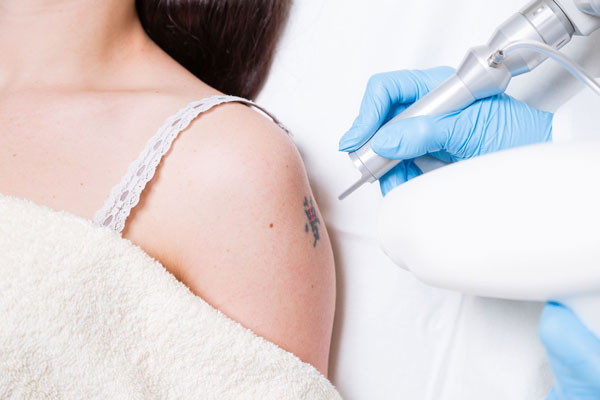Unveiling the truth about laser tattoo removal side effects is crucial for anyone considering this procedure. Understanding the potential risks and benefits can help you make an informed decision.
While laser technology has advanced significantly, side effects like skin discoloration, scarring, and infection remain possible.
It’s essential to consult with a qualified professional to assess your individual risk factors and ensure a safe treatment process. Stay informed to navigate the world of tattoo removal effectively.
Understanding Tattoo Removal
Options Explored
Surgical excision and dermabrasion are alternative methods for tattoo removal besides laser treatment. These procedures involve physically removing the tattooed skin or sanding it down to fade the ink.
- Surgical excision offers quick results but may leave scars.
- Dermabrasion involves scraping off the top layers of skin, causing redness and discomfort.
Consider the pros and cons of each method before deciding on a suitable approach. While surgical excision provides immediate results, it carries a risk of scarring. On the other hand, dermabrasion is less invasive but requires multiple sessions for effective results.
Expected Results
Laser tattoo removal typically yields gradual outcomes, with fading occurring over several sessions. The process may take several months to complete based on factors like tattoo size, ink colors, and individual skin type.
Factors such as skin type and ink depth can influence the efficiency of laser removal. Darker inks are usually easier to remove than lighter ones. Professional tattoos may require more sessions compared to amateur ones due to their deeper penetration into the skin.
Multiple sessions are crucial for achieving complete tattoo removal. Each session targets different layers of ink, gradually breaking them down for absorption by the body’s immune system.
Delving into Laser Removal
Process Overview
Laser tattoo removal involves a multi-step process starting with a consultation to assess the tattoo’s size, colors, and location. During treatment, laser wavelengths are directed at the tattoo, breaking down ink particles into tiny fragments. The body’s immune system then naturally eliminates these particles over time.
Consultation is crucial to determine the number of laser sessions needed based on the tattoo’s characteristics and the individual’s skin type. After each session, proper aftercare is essential to aid in skin healing and minimize potential side effects like redness or blistering.
Technology Used
Advanced laser technologies like Nd YAG laser are commonly employed for tattoo removal due to their ability to target specific ink colors effectively. Different types of lasers, such as Q-switched and picosecond lasers, offer varying benefits in terms of speed and efficiency in breaking down ink particles.
Choosing a reputable clinic equipped with modern laser technology is vital for safe and successful tattoo removal. Modern equipment ensures precise targeting of ink pigments while minimizing damage to surrounding skin tissues. Prioritizing quality technology can enhance the overall effectiveness of the removal process.
5 Side Effects Overview
Immediate Effects
Pain
Laser tattoo removal may cause discomfort, with sensations varying from person to person. Using numbing creams before the procedure can help manage pain. Individuals’ pain tolerance plays a significant role in how they perceive the level of pain.
Redness
Redness is a common immediate side effect of laser tattoo removal due to the skin’s reaction to the treatment. Typically, redness lasts for a few days post-procedure. To reduce redness, it is recommended to apply cool compresses and use gentle skincare products.
Swelling
After laser tattoo removal, some individuals may experience swelling in the treated area. Applying ice packs can help minimize swelling. Swelling usually subsides within a few days following the procedure.
Delayed Effects
Scarring
There is a risk of scarring associated with laser tattoo removal if proper aftercare is not followed. Adequate care post-treatment can significantly reduce the likelihood of scarring. It’s essential to differentiate between temporary redness and permanent scarring for appropriate management.
Texture Changes
Laser tattoo removal can temporarily affect the skin’s texture, leading to dryness or flakiness. Using hydrating skincare products and following a proper skincare routine can help address these textural changes during the healing process.
Pain Management Techniques
During Procedure
When undergoing laser tattoo removal, patients can expect a sensation similar to rubber band snaps. Practitioners prioritize safety by providing protective eyewear and shielding the surrounding skin. Communication is key; any discomfort levels should be promptly shared with the practitioner.
Post-Procedure
Immediately after laser tattoo removal, apply ice packs to reduce swelling and discomfort. Following post-procedure care instructions diligently is crucial for optimal healing. It’s common to experience blistering or itching, which can be managed with prescribed ointments.
Addressing Common Complications
Preventing Scarring
To minimize the risk of scarring after laser tattoo removal, keep the treated area clean and moisturized. This promotes proper healing and reduces the chances of scarring. Applying sunscreen is crucial to protect the skin during the healing process.
Maintaining cleanliness and hydration post-treatment aids in preventing scarring by supporting healthy tissue regeneration. Proper wound care is essential to avoid complications such as keloids or hypertrophic scars. Using gentle cleansers and following aftercare instructions diligently can significantly reduce the likelihood of scarring.
Managing Pigmentation
Laser tattoo removal may impact skin pigmentation, leading to hyperpigmentation or hypopigmentation. Hyperpigmentation results in darkened skin areas, while hypopigmentation causes lightened patches. It’s vital to understand these potential side effects and seek professional advice on managing any pigment changes.
Post-treatment, managing pigmentation changes involves protecting the skin from excessive sun exposure to prevent further pigmentation issues. Consult with a dermatologist for tailored solutions like topical treatments or skincare routines that help restore skin tone balance effectively. Regular follow-ups can address any pigment-related concerns promptly.
Aftercare Recommendations
Immediate Care
Right after a laser tattoo removal session, immediate care is crucial. Keep the treated area clean by gently washing it with mild soap and water. Avoid harsh chemicals that can irritate the skin. Apply a thin layer of antibiotic ointment and cover the area with a sterile bandage to protect against infection.
Managing discomfort and potential side effects is essential. Apply cold compresses to reduce swelling and soothe the skin. Avoid picking at scabs to prevent scarring. Stay hydrated and follow any specific instructions provided by your healthcare provider for optimal healing.
Long-Term Care
For long-term care post laser tattoo removal, focus on maintaining skin health. Protect your skin from the sun by using sunscreen with at least SPF 30 daily. Incorporate a gentle skincare routine to promote healing and prevent irritation.
Regularly monitor the treated area for any signs of complications such as excessive redness, swelling, or discharge. If you notice any concerning symptoms, contact your healthcare provider immediately for further evaluation and guidance.
Closing Thoughts
Now that you understand the ins and outs of laser tattoo removal, including potential side effects, pain management strategies, common complications, alternative methods, and aftercare tips, you’re better equipped to make informed decisions about your tattoo removal journey. Remember, while laser removal is effective, it’s essential to consider all aspects and consult with professionals to ensure a safe and successful process. Prioritize your skin health and follow the recommended aftercare diligently to promote optimal healing.
Take charge of your tattoo removal experience by staying proactive in your research and discussions with experts. Your commitment to understanding the process and caring for your skin post-treatment will not only enhance results but also contribute to a smoother recovery. Embrace the journey towards tattoo-free skin with confidence and patience, knowing that you’re taking the necessary steps for a successful outcome.
Image credit: https://www.verywellhealth.com/laser-tattoo-removal-wait-times-2710217


